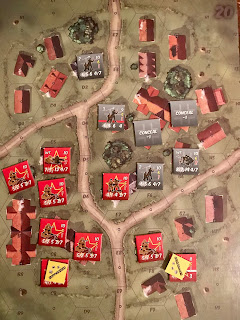After two years of 2" square bases with 2 figures each, I have decided it's time to change things up for my WWII Eastern Front collection.
The impetus for this was the realization that board games give me everything I want in a squad based game, with the ability to put more troops, guns, armor, and buildings on the table than I could ever manage (at least in 54mm/1/32, even with 1/43-1/50 vehicles). The other push came from basing my Venusian figures on 1.5" round bases with a single figure each. I just really like how this looks.
This still leaves questions about what kind of game am I hoping to get from this particular collection to justify it's taking up of space.
I already have
single-figure basing for Western Europe, with British paratroopers and
American infantry vs German Waffen SS. Those figures are Britain and Conte, scored when I find great deals, so they are rather small forces of a squad each. That means squad or less per side gaming. The Eastern Front has to be something larger than that as I can field slightly more than a 1:1 platoon, never mind the support weapons. If I'm only using 10 or so figures, why hold on to 3 or 4 times that?
A recent revisiting of Grant's Battle was particularly inspiring. I was most taken by the devil-may-care attitude towards TO&Es when equipping one's armies (admittedly this was much due to availability of suitable models when it was written as due to the author's ethos), but also the abstraction of counting one figure as more than one man. I realize this is fairly common for many gamers, but for WWII, in my own gaming, I have either done 1:1 or used trays (Morschauser's term) where the figure count was irrelevant, the tray was the thing.
In any case, this also had me contemplating Lionel Tarr's rules and Featherstone's simple WWII rules, which both treat 10 figures as a company. Grant calls his units platoons, but he's using 20mm figures and his ground scale of 1 inch = 33 1/3 yards, so to my mind that makes them more like companies. There's that nerdy obsession with ranges and unit frontages and "getting it right" (something I'm really trying to let go of).
Regardless of the specific figure count, this level of abstraction appeals to me as does the general nature of the "old school" approach - especially rolling to attack for each figure with the weapon they are equipped with and individual figure removal of casualties, which seems appropriately "toy soldiery". Admittedly Featherstone and Tarr cause multiple casualties from attacks by a single figure, but they were probably using more figures than I am with 54mm figures on my 38" square card table. My 48" table may however allow me field a battalion with support and armor and I could try their mechanics as written.
The Portable Wargame also works well for me and I have come to like the look of individually based figures in a grid space for this period - at least other people's games of such - so this will allow me to achieve those aesthetics. Finally, it turns out that 6 figures placed on a 6"x 3" movement tray make a nice unit for One Hour Wargames style WWII forces (again though I prefer to treat the base as a company).
All of that said, I am going to refrain from painting the round bases any time soon. Until I've played a few more games to confirm this is the way forward (for now), I'd rather not use up precious hobby time painting the bases. I've also saved the square bases, just in case. Because I do nothing but a simple paint job on them, reattaching the figures is a quick process.


















